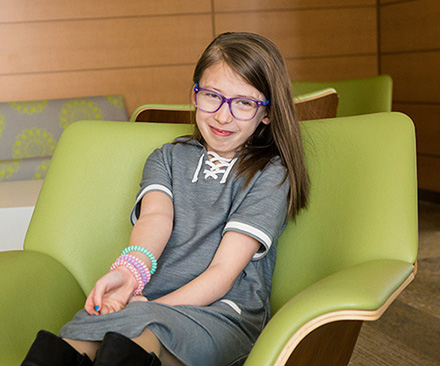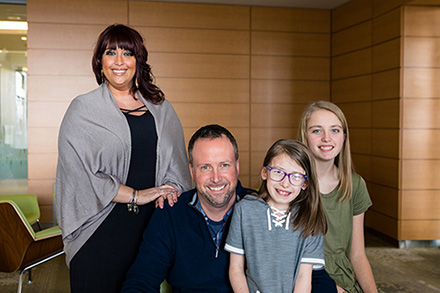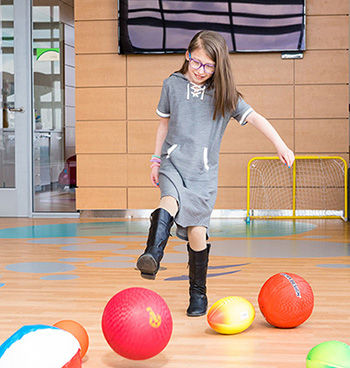Miracle Kid: Lauren Gumtow
Scoliosis Patient Thriving After Innovative Surgery
 Emerging from the procedure with eight pins affixed to her skull, Lauren Gumtow awoke beside her new walker, which was attached to the metal halo around her forehead.
Emerging from the procedure with eight pins affixed to her skull, Lauren Gumtow awoke beside her new walker, which was attached to the metal halo around her forehead.
But as the anesthesia wore off, the 6-year-old took note of her newfound equipment and realized it might give her an unanticipated edge in combat. She smiled at her mother.
“Want to fight?”
The procedure, in January 2014, was just another step for Lauren, who had been diagnosed with severe scoliosis three years earlier. But her bright attitude helped her family get through the toughest times, and just three months after the halo was put into place, Lauren would become one of the first scoliosis patients in the United States to be outfitted with a special new growing rod.
The new device, installed at UR Medicine’s Golisano Children’s Hospital in April, can be lengthened magnetically as a child grows, and will drastically reduce the number of surgeries Lauren needs while she makes her way toward recovery.
The Journey
Born in 2007, Lauren was just 2 days old when she was diagnosed with tetralogy of Fallot, a congenital heart defect which results in low oxygenation of the blood. George Alfieris, M.D., director of pediatric cardiac surgery at Golisano Children’s Hospital, performed her open heart surgery in October 2007.
“So she’s really had the journey,” said Kelly Gumtow, Lauren’s mother.
At age 3, Lauren began to show signs of scoliosis, and she returned to Golisano Children’s Hospital where she began meeting with James Sanders, M.D., chief of the Division of Pediatric Orthopaedics. Though Lauren was only 3 years old at the time, Sanders knew that her scoliosis was acute enough that treatment needed to progress quickly.
“The curve was so severe that, if untreated, it was highly likely to eventually cause her lungs to fail,” Sanders said.
Sanders knew that a brace wouldn't be enough to correct the spine curve, but he was hoping to keep the scoliosis under control until Lauren was old enough for a growing rod surgery. After a series of casts to help limit the spine curve, Sanders placed Lauren in a Milwaukee brace, a device flexible enough to allow her to continue being a kid.
“She’s just a girly girl. She loves dressing up, putting on makeup, playing with her sister,” Kelly Gumtow said. “It’s emotional at times, because you never stop asking ‘Why?’ But it’s been very humbling because she’s such a trooper. Nothing gets her down.”
Eventually, as expected, Lauren’s scoliosis started to worsen, necessitating the halo traction procedure. Pins were placed in her skull and a halo was attached to a walker, which stayed with Lauren wherever she went.
Halo traction, which uses weights to apply steady upward pressure on the head, attempts to pull the spine into a straighter position. It worked well for Lauren, allowing her to breathe more easily, but the restrictions that accompanied it made it tough for her to do the same things she used to do.
 “Basically, she couldn't be a kid,” said Matt Gumtow, Lauren’s father. “She couldn’t play with her sister, lie on the floor, lie on the couch – the simple things you take for granted.”
“Basically, she couldn't be a kid,” said Matt Gumtow, Lauren’s father. “She couldn’t play with her sister, lie on the floor, lie on the couch – the simple things you take for granted.”
Lauren’s parents set up a table for her in the living room where she could play with her toys from her walker or wheelchair. She grew fond of the Disney movie Frozen, and the television shows Doc McStuffins and Sofia the First. And soon, she was able to start going back to school at Washington West Elementary in Olean. The school was very supportive of Lauren’s needs, allowing her grandfather to accompany her to class every day, and her mother, the school counselor, was never far away.
Growing Rod
By April 2014, it was time for the growing rod to be installed. But while traditional growing rods need to be lengthened every six months — requiring an additional surgery for every adjustment — Lauren received a newly-approved device that uses a magnetic motor to allow doctors to make adjustments externally.
The magnetic growing rod, called the MAGEC System, has been used successfully in Europe for several years, but was only approved by the United States Food and Drug Administration in February. Lauren’s surgery made Golisano Children’s Hospital just the second hospital in the country to install one of the devices since its approval.
 “Surgery is traumatic for children, and every time you open up the skin, particularly through an old scar, you increase your risk of infection,” Sanders said. “So anything we can do to try to continue the spine’s growth but decrease the amount of surgeries is a very good thing.”
“Surgery is traumatic for children, and every time you open up the skin, particularly through an old scar, you increase your risk of infection,” Sanders said. “So anything we can do to try to continue the spine’s growth but decrease the amount of surgeries is a very good thing.”
Now 10 years old, Lauren has received 13 lengthenings of her growing rod, all done in a simple outpatient procedure using the MAGEC remote. She’s now playing soccer, and her confidence is growing on a daily basis.
Lauren will need an additional surgery at some point soon to switch the rod out with a larger model, but that only underscores the fact that she’s growing so well now, said her mother.
“It’s put life in perspective. It’s put our family in perspective,” Kelly Gumtow said. “I think it’s made us stronger.”
Make a gift to Golisano Children's Hospital and help other kids, like Lauren, receive the care they need.